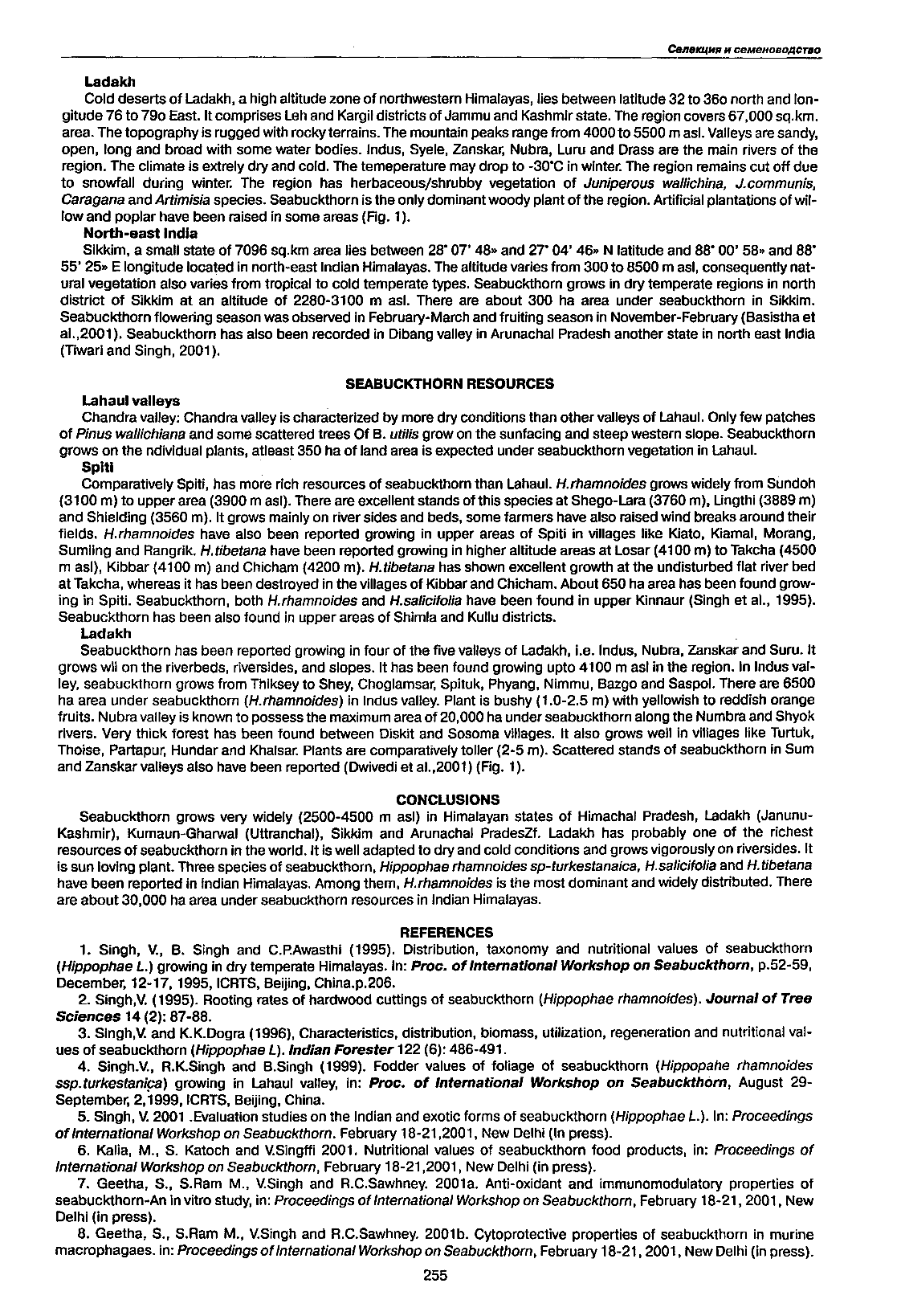

Селекций и семеноводство
Ladakh
Cold deserts of Ladakh, a high altitude zone of northwestern Himalayas, lies between latitude 32 to 36o north and lon
gitude 76 to 79o East. It comprises Leh and Kargil districts of Jammu and Kashmir state. The region covers 67,000
sq.km,
area. The topography is rugged with rocky terrains. The mountain peaks range from 4000 to 5500 m asl. Valleys are sandy,
open, long and broad with some water bodies. Indus, Syele, Zanskar, Nubra, Luru and Drass are the main rivers of the
region. The climate is extrely dry and cold. The temeperature may drop to -30*C in winter. The region remains cut off due
to snowfall during winter. The region has herbaceous/shrubby vegetation of
Juniperous wallichina, J.communis,
Caragana
and
Artimisia
species. Seabuckthorn is the only dominant woody plant of the region. Artificial plantations of wil
low and poplar have been raised in some areas (Fig. 1).
North-east India
Sikkim, a small state of 7096
sq.kmarea lies between 28* 07* 48» and 27* 04* 46» N latitude and 88* 00’ 58» and 88*
55’ 25» E longitude located in north-east Indian Himalayas. The altitude varies from 300 to 8500 m asl, consequently nat
ural vegetation also varies from tropical to cold temperate types. Seabuckthorn grows in dry temperate regions in north
district of Sikkim at an altitude of 2280-3100 m asl. There are about 300 ha area under seabuckthorn in Sikkim.
Seabuckthorn flowering season was observed in February-March and fruiting season in November-February (Basistha et
al.,2001). Seabuckthorn has also been recorded in Dibang valley in Arunachal Pradesh another state in north east India
(Tiwari and Singh, 2001).
SEABUCKTHORN RESOURCES
Lahaul valleys
Chandra valley: Chandra valley is characterized by more dry conditions than other valleys of Lahaul. Only few patches
of
Pinus watlichiana
and some scattered trees Of B.
utilis
grow on the sunfacing and steep western slope. Seabuckthorn
grows on the ndividual plants, atleast 350 ha of land area is expected under seabuckthorn vegetation in Lahaul.
Spiti
Comparatively Spiti, has more rich resources of seabuckthorn than Lahaul.
H.rhamnoides
grows widely from Sundoh
(3100 m) to upper area (3900 m asl). There are excellent stands of this species at Shego-Lara (3760 m), Lingthi (3889 m)
and Shielding (3560 m). It grows mainly on river sides and beds, some farmers have also raised wind breaks around their
fields.
H.rhamnoides
have also been reported growing in upper areas of Spiti in villages like Kiato, Kiamal, Morang,
Sumling and Rangrik.
H.tibetana
have been reported growing in higher altitude areas at Losar (4100 m) to Takcha (4500
m asl), Kibbar (4100 m) and Chicham (4200 m).
H.tibetana
has shown excellent growth at the undisturbed flat river bed
at Takcha, whereas it has been destroyed in the villages of Kibbar and Chicham. About 650 ha area has been found grow
ing in Spiti. Seabuckthorn, both
H.rhamnoides
and
H.salicifolia
have been found in upper Kinnaur (Singh et al., 1995).
Seabuckthorn has been also found in upper areas of Shimla and Kullu districts.
Ladakh
Seabuckthorn has been reported growing in four of the five valleys of Ladakh, i.e. Indus, Nubra, Zanskar and Suru. It
grows wll on the riverbeds, riversides, and slopes. It has been found growing upto 4100 m asl in the region. In Indus val
ley, seabuckthorn grows from Thiksey to Shey, Choglamsar, Spituk, Phyang, Nimmu, Bazgo and Saspol. There are 6500
ha area under seabuckthorn (
H.rhamnoides)
in Indus valley. Plant is bushy (1.0-2.5 m) with yellowish to reddish orange
fruits. Nubra valley is known to possess the maximum area of 20,000 ha under seabuckthorn along the Numbra and Shyok
rivers. Very thick forest has been found between Diskit and Sosoma villages. It also grows well in villages like Turtuk,
Thoise, Partapur, Hundar and Khalsar. Plants are comparatively toller (2-5 m). Scattered stands of seabuckthorn in Sum
and Zanskar valleys also have been reported (Dwivedi et al.,2001) (Fig. 1).
CONCLUSIONS
Seabuckthorn grows very widely (2500-4500 m asl) in Himalayan states of Himachal Pradesh, Ladakh (Janunu-
Kashmir), Kumaun-Gharwal (Uttranchal), Sikkim and Arunachal PradesZf. Ladakh has probably one of the richest
resources of seabuckthorn in the world. It is well adapted to dry and cold conditions and grows vigorously on riversides. It
is sun loving plant. Three species of seabuckthorn,
Hippophae rhamnoides sp-turkestanaica, H.salicifolia
and
H.tibetana
have been reported in Indian Himalayas. Among them,
H.rhamnoides
is the most dominant and widely distributed. There
are about 30,000 ha area under seabuckthorn resources in Indian Himalayas.
REFERENCES
1. Singh, V., B. Singh and C.P.Awasthi (1995). Distribution, taxonomy and nutritional values of seabuckthorn
(Hippophae L.)
growing in dry temperate Himalayas. In:
Proc
-
o f International Workshop on Seabuckthorn
, p.52-59,
December, 12-17,1995, ICRTS, Beijing, China.p.206.
2. Singh,V. (1995). Rooting rates of hardwood cuttings of seabuckthorn
(Hippophae rhamnoides). Journal o f Tree
Sciences
14 (2): 87-88.
3. Singh,V. and K.K.Dogra (1996), Characteristics, distribution, biomass, utilization, regeneration and nutritional val
ues of seabuckthorn
(Hippophae L). Indian Forester
122 (6): 486-491.
4. Singh.V., R.K.Singh and B.Singh (1999). Fodder values of foliage of seabuckthorn (
Hippopahe rhamnoides
ssp.turkestanica)
growing in Lahaul valley, in:
Proc.
o f international Workshop on Seabuckthorn
, August 29-
September, 2,1999, ICRTS, Beijing, China.
5. Singh, V. 2001 .Evaluation studies on the Indian and exotic forms of seabuckthorn
(Hippophae L ).
In:
Proceedings
o f International Workshop on Seabuckthorn
. February 18-21,2001, New Delhi (In press).
6. Kalia, M., S. Katoch and V.Singffi 2001. Nutritional values of seabuckthorn food products, in:
Proceedings o f
International Workshop on Seabuckthorn
, February 18-21,2001, New Delhi (in press).
7. Geetha, S., S.Ram M., V.Singh and R.C.Sawhney. 2001a. Anti-oxidant and immunomodulatory properties of
seabuckthorn-An in vitro study, in:
Proceedings of International Workshop on Seabuckthorn
, February 18-21,2001, New
Delhi (in press).
8. Geetha, S., S.Ram M., V.Singh and R.C.Sawhney. 2001b. Cytoprotective properties of seabuckthorn in murine
macrophagaes. in:
Proceedings o f International Workshop on Seabuckthorn
, February 18-21,2001, New Delhi (in press).
255
Научная электронная библиотека ЦНСХБ









